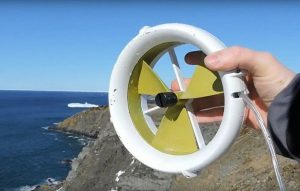More and more often in the market of novelties of small electronics began to meet the devices, allowing charging gadgets in the conditions of absence of an electric system. Portable batteries that work on solar panels are already not new to anyone. However, progress does not stand still.
Recently it known about the launch of another innovation under the name Waterlily. This development is a portable small-sized turbine that can use the energy of water and wind to generate electricity.
Camp generators of the new generation allow providing camping with electricity, but in the majority, they are able to use only one energy source. Some generators produce electricity from the sun, others – from the wind, others are effective in the water environment. Portable turbine Waterlily is in this case more functional, as it is able to generate electricity by both wind and water. This approach allows it to significantly expanding the scope of application.
The dimensions of the microturbine are 180 * 75 mm, and the weight is only 0.8 kg. The design of the device makes it possible to install it under the water column or in the wind. The turbine generates enough power to charge a not too large device. The charging process occurs by connecting a USB cable.
 Turbine Waterlily begins to generate energy in the water environment, when the flow has a speed of one kilometer per hour. The maximum permissible flow rate is 11 km / h. The manufacturer states that the largest power the turbine can produce is 25 watts. The device is capable of achieving this value at a water flow rate of about 7 km / h.
Turbine Waterlily begins to generate energy in the water environment, when the flow has a speed of one kilometer per hour. The maximum permissible flow rate is 11 km / h. The manufacturer states that the largest power the turbine can produce is 25 watts. The device is capable of achieving this value at a water flow rate of about 7 km / h.
To generate electric power by means of a wind turbine, a flow of air with a speed of at least 11 km / h is necessary. The maximum productivity of the turbine in the wind is reach at a wind speed of about 72 km / h.
Developers at this stage are working on adding a handle to the device. This will allow have some minimum amount of energy in conditions of windless weather or absence near water bodies. Such an improvement will make it possible, if not to charge the gadget, at least not to allow the battery to be completely discharge.
 Representatives of the company report that the testing of the turbine was carry out using a bicycle and a towrope. Consequently, it is possible to use a microturbine by attaching it to a bike or boat.
Representatives of the company report that the testing of the turbine was carry out using a bicycle and a towrope. Consequently, it is possible to use a microturbine by attaching it to a bike or boat.
The Waterlily device is not yet on sale and is not available to the public. The company accepts preliminary applications for a microturbine. It is plan to ship the first batch of portable turbines before the end of August this year. The first models will have a cost of about a hundred dollars, and they plan to sell them at retail for 149 dollars.

